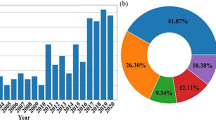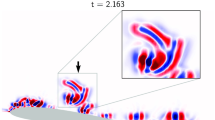Abstract
We present a model order reduction approach for parametrized laminar flow problems including viscous boundary layers. The viscous effects are captured by the incompressible Navier–Stokes equations in the vicinity of the boundary layer, whereas a potential flow model is used in the outer region. By this, we provide an accurate model that avoids imposing the Kutta condition for potential flows as well as an expensive numerical solution of a global viscous model. To account for the parametrized nature of the problem, we apply the reduced basis method. The accuracy of the reduced order model is ensured by rapidly computable a posteriori error estimates. The main contributions of this paper are the combination of an offline-online splitting with the domain decomposition approach, reducing both offline and online computational loads and a new kernel interpolation method for the approximation of the stability factor in the online evaluation of the error estimate. The viability of our approach is demonstrated by numerical experiments for the section of a NACA airfoil.













Similar content being viewed by others
References
Abbott, I., von Doenhoff, A.: Theory of Wing Sections. Dover Publications, New York (1959)
Barrault, M., Maday, Y., Nguyen, N., Patera, A.: An “empirical interpolation” method: application to efficient reduced-basis discretization of partial differential equations. Comptes Rendus Acad. Sci. Ser. I(339), 667–672 (2004)
Benner, P., Feng, L.: Model order reduction for coupled problems. Tech. Rep. MPIMD/15-02, Max Planck Institue for Dynamics of Complex Technical Systems, Magdeburg (2015)
Binev, P., Cohen, A., Dahmen, W., DeVore, R., Petrova, G., Wojtaszczyk, P.: Convergence rates for greedy algorithms in reduced basis methods. SIAM J. Math. Anal. 43(3), 1457–1472 (2011)
Brezzi, F., Rappaz, J., Raviart, P.: Finite dimensional approximation of nonlinear problems. Part I: branches of nonsingular solutions. Numer. Math. 36, 1–25 (1980)
Buhr, A., Engwer, C., Ohlberger, M., Rave, S.: A numerically stable a posteriori error estimator for reduced basis approximations of elliptic equations. In: Proceedings of the 11th World Congress on Computational Mechanics CIMNE, Barcelona, pp. 4094–4102 (2014)
Caloz, G., Rappaz, J.: Numerical analysis for nonlinear and bifurcation problems. In: Ciarlet, P., Lions, J. (eds.) Handbook of Numerical Analysis, pp. 487–637. Elsevier, Amsterdam (1997)
Deparis, S., Løvgren, E.: Stabilized reduced basis approximation of incompressible three-dimensional Navier–Stokes equations in parametrized deformed domains. J. Sci. Comput. 50(1), 198–212 (2012)
Dinh, Q., Glowinski, R., Périaux, J., Terrasson, G.: On the coupling of viscous and inviscid models for incompressible fluid flows via domain decomposition. In: Domain Decomposition Methods for Partial Differential Equations, pp. 350–369. SIAM, Philadelphia (1988)
Discacciati, M., Quarteroni, A.: Navier–Stokes/Darcy coupling: modeling, analysis, and numerical approximation. Rev. Mat. Complut. 22(2), 315–426 (2009)
Eftang, J., Patera, A.: Port reduction in parametrized component static condensation: approximation and a posteriori error estimation. Int. J. Numer. Methods Eng. 96(5), 269–302 (2013). doi:10.1002/nme.4543
Gerner, A., Veroy, K.: Certified reduced basis methods for parametrized saddle point problems. SIAM J. Sci. Comput. 34(5), A2812–A2836 (2012)
Giraud, L., Langou, J., Rozloznik, M.: The loss of orthogonality in the Gram-Schmidt orthogonalization process. Comput. Math. Appl. 50, 1069–1075 (2005)
Girault, V., Raviart, P.A.: Finite Element Methods for Navier–Stokes Equations: Theory and Algorithms. Springer Series in Computational Mathematics. Springer, Berlin (1986)
Grepl, M., Patera, A.: A posteriori error bounds for reduced-basis approximations of parametrized parabolic partial differential equations. Math. Model. Numer. Anal. 39, 157–181 (2005)
Haasdonk, B., Ohlberger, M.: Adaptive basis enrichment for the reduced basis method applied to finite volume schemes. In: Proceedings of 5th International Symposium on Finite Volumes for Complex Applications, pp. 471–478 (2008)
Haasdonk, B., Ohlberger, M.: Reduced basis method for finite volume approximations of parametrized linear evolution equations. Math. Model. Numer. Anal. 42, 277–302 (2008)
Hesthaven, J., Rozza, G., Stamm, B.: Certified Reduced Basis Methods for Parametrized Partial Differential Equations. SpringerBriefs in Mathematics. Springer, Berlin (2016)
Huynh, D., Knezevic, D., Chen, Y., Hesthaven, J., Patera, A.: A natural-norm successive constraint method for inf-sup lower bounds. Comput. Methods Appl. Mech. Eng. 199, 1963–1975 (2010)
Huynh, D., Knezevic, D., Patera, A.: A static condensation reduced basis element method: approximation and a posteriori error estimation. Math. Model. Numer. Anal. 47(1), 213–251 (2013)
Huynh, D., Rozza, G., Sen, S., Patera, A.: A successive constraint linear optimization method for lower bounds of parametric coercivity and inf-sup stability constants. Comptes Rendus Acad. Sci. Ser. I(345), 473–478 (2007)
Iapichino, L., Quarteroni, A., Rozza, G.: Reduced basis method and domain decomposition for elliptic problems in networks and complex parametrized geometries. Comput. Math. Appl. 71(1), 408–430 (2016)
Iapichino, L., Quarteroni, A., Rozza, G.: A reduced basis hybrid method for the coupling of parametrized domains represented by fluidic networks. Comput. Methods Appl. Mech. Eng. 221–222, 62–82 (2012)
John, V.: Higher order finite element methods and multigrid solvers in a benchmark problem for the 3D Navier–Stokes equations. Int. J. Numer. Methods Fluids 40, 775–798 (2002). doi:10.1002/fld.377
Løvgren, A., Maday, Y., Rønquist, E.: A reduced basis element method for the steady Stokes problem. Math. Model. Numer. Anal. 40, 529–552 (2006)
Maday, Y., Rønquist, E.: A reduced-basis element method. J. Sci. Comput. 17, 447–459 (2002)
Maday, Y., Rønquist, E.: The reduced basis element method: application to a thermal fin problem. J. Sci. Comput. 26, 240–258 (2004)
Maier, I., Haasdonk, B.: A Dirichlet–Neumann reduced basis method for homogeneous domain decomposition problems. Appl. Numer. Math. 78, 31–48 (2014). doi:10.1016/j.apnum.2013.12.001
Manzoni, A.: Reduced models for optimal control, shape optimization and inverse problems in haemodynamics. Ph.D. thesis, EPFL, Lausanne (2012)
Manzoni, A.: An efficient computational framework for reduced basis approximation and a posteriori error estimation of parametrized Navier–Stokes flows. Math. Model. Numer. Anal. 48(4), 1199–1226 (2014)
Manzoni, A., Negri, F.: Rigorous and heuristic strategies for the approximation of stability factors in nonlinear parametrized PDEs. Adv. Comput. Math. 41(5), 1255–1288 (2015). doi:10.1007/s10444-015-9413-4
Manzoni, A., Salmoiraghi, F., Heltai, L.: Reduced basis isogeometric methods (RB-IGA) for the real-time simultion of potential flows about parametrized NACA airfoils. Comput. Methods Appl. Mech. Eng. 284, 1147–1180 (2015)
Martini, I., Haasdonk, B.: Output error bounds for the Dirichlet–Neumann reduced basis method. In: Numerical Mathematics and Advanced Applications-ENUMATH 2013, Lecture Notes in Computational Science and Engineering, vol. 103, pp. 437–445 (2015). doi:10.1007/978-3-319-10705-9_43
Martini, I., Rozza, G., Haasdonk, B.: Reduced basis approximation and a-posteriori error estimation for the coupled Stokes–Darcy system. Adv. Comput. Math. 41(5), 1131–1157 (2015). doi:10.1007/s10444-014-9396-6
Panton, R.: Incompressible Flow. Wiley, Hoboken (1996)
Patera, A., Rozza, G.: Reduced Basis Approximation and A Posteriori Error Estimation for Parametrized Partial Differential Equations. MIT Pappalardo Graduate Monographs in Mechanical Engineering (2007). http://augustine.mit.edu
Pitton, G., Rozza, G.: On the application of reduced basis methods to bifurcation problems in incompressible fluid dynamics. J. Sci. Comput. (2017). doi:10.1007/s10915-017-0419-6
Quarteroni, A., Rozza, G., Manzoni, A.: Certified reduced basis approximation for parametrized partial differential equations and applications. J. Math. Ind. 1, 3 (2011). doi:10.1186/2190-5983-1-3
Quarteroni, A., Sacchi Landriani, G., Valli, A.: Coupling of viscous and inviscid Stokes equations via a domain decomposition method for finite elements. Numer. Math. 59, 831–859 (1991)
Quarteroni, A., Valli, A.: Domain Decomposition Methods for Partial Differential Equations. Oxford University Press, Oxford (1999)
Rozza, G., Huynh, D., Manzoni, A.: Reduced basis approximation and a posteriori error estimation for Stokes flow in parametrized geometries: roles of the inf-sup stability constants. Numer. Math. 125, 115–152 (2013)
Rozza, G., Huynh, D., Patera, A.T.: Reduced basis approximation and a posteriori error estimation for affinely parametrized elliptic coercive partial differential equations. Arch. Comput. Methods Eng. 15, 229–275 (2008)
Rozza, G., Veroy, K.: On the stability of the reduced basis method for Stokes equations in parametrized domains. Comput. Methods Appl. Mech. Eng. 196, 1244–1260 (2007)
Schenk, K., Hebeker, F.: Coupling of two-dimensional viscous and inviscid incompressible stokes equations. In: Hebeker, F., Rannacher, R., Wittum, G. (eds.) Numerical Methods for the Navier–Stokes Equations, pp. 239–248. Springer Fachmedien Wiesbaden, Wiesbaden (1993)
Smetana, K.: A new certification framework for the port reduced static condensation reduced basis element method. Comput. Methods Appl. Mech. Eng. 283, 352–383 (2015)
Temam, R.: Navier–Stokes Equations: Theory and Numerical Analysis. AMS Chelsea Publishing, Providence (2001)
Vallaghé, S., Patera, A.: The static condensation reduced basis element method for a mixed-mean conjugate heat exchanger model. SIAM J. Sci. Comput. 36(3), B294–B320 (2013)
Veroy, K., Patera, A.: Certified real-time solution of the parametrized steady incompressible Navier–Stokes equations: rigorous reduced-basis a posteriori error bounds. Int. J. Numer. Methods Fluids 47, 773–788 (2005)
Veroy, K., Prud’homme, C., Rovas, D., Patera, A.: A posteriori error bounds for reduced-basis approximation of parametrized noncoercive and nonlinear elliptic partial differential equations. In: Proceedings of 16th AIAA Computational Fluid Dynamics Conference, p. 3847 (2003)
Acknowledgements
The authors would like to thank the Trans-Domain COST Action TD1307 “European Model Reduction Network” (EU-MORNET) for the grant of a Short Term Scientific Mission (STSM), allowing I. Martini to spend a visiting period at SISSA. We also acknowledge financial support by the German Research Foundation (DFG) within the Cluster of Excellence in Simulation Technology (EXC 310/1) at the University of Stuttgart and by the Baden-Württemberg Stiftung gGmbH. G. Rozza acknowledges the NOFYSAS program: New Opportunities for Young Scientists at SISSA, Trieste, Italy and the INDAM-GNCS projects 2015–2016.
Author information
Authors and Affiliations
Corresponding author
Rights and permissions
About this article
Cite this article
Martini, I., Haasdonk, B. & Rozza, G. Certified Reduced Basis Approximation for the Coupling of Viscous and Inviscid Parametrized Flow Models. J Sci Comput 74, 197–219 (2018). https://doi.org/10.1007/s10915-017-0430-y
Received:
Revised:
Accepted:
Published:
Issue Date:
DOI: https://doi.org/10.1007/s10915-017-0430-y




